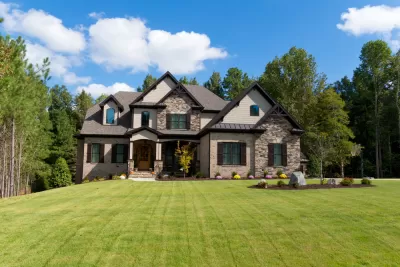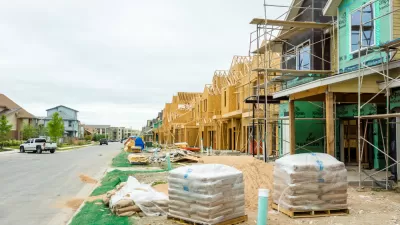The U.S. remains largely a suburban nation, though central cities are experiencing a great comeback after years of population loss. But what exactly is a suburb? A new report from the Urban Land Institute provides answers by providing subcategories.

"The report, Housing in the Evolving American Suburb [PDF], provides a new analytic framework developed by RCLCO [Real Estate Advisors] for the ULI Terwilliger Center for Housing that describes different kinds of suburbs based on the key factors that define and determine their housing markets," writes Robert Krueger in a press release for ULI.
The report classifies and compares suburbs in the 50 largest metro areas in the U.S. – shown in a searchable online map – and assesses the key issues that will shape suburban residential demand and development in the years ahead.
Krueger list seven bullets that show the dominance of suburbs over central cities in terms of population, employment, and other demographics. Two exceptions:
- Between 2005 and 2010, employment in suburban areas remained stagnant, while it increased by 8.2 percent in urban areas. But between 2010 and 2014, jobs increased by 9 percent in suburbs versus 6 percent in urban areas.
- The regional variation in home values between suburbs and cities is substantial. On average, the median home value in urban areas is $365,000 compared to $305,000 in suburban areas.
Among suburbs, the report considers three categories:
- High-density suburban: relatively dense outer neighborhoods and commercial corridors.
- Suburban: well-populated neighborhoods where most of the housing stock consists of single-family detached homes.
- Low-density suburban: neighborhoods where most of the housing stock consists of single-family detached homes, and where there is some undeveloped land.
One disturbing characteristic they all share: "Auto dependence is uniformly high across all types of suburbs, even in those with better access to transit."
The report further differentiates suburbs into "five suburban paradigms" ranging from "established high-end suburbs" to "greenfield value suburbs." See page 5 of report [PDF] for their definitions.
Laura Kusisto of The Wall Street Journal was the first to report on the analysis. The "research shows that suburbs are continuing to outstrip downtowns in overall population growth, diversity and even younger residents," writes Kusisto (also see short summary of the article, fully accessible on Builder).
The Journal's '"binary classification" prompted Joe Cortright to review her article for City Observatory:
Last Friday’s Wall Street Journal came out with another eye-catching headline story in the city versus suburbs battle of the bands: “Suburbs outstrip cities in population growth, study finds."
On its face, the article seems to imply that much of what has been written in recent years about a rebound in cities is either wrong or somehow overstated.
Cortright suggests to his readers that they read the ULI press release to understand how their report is not an urban vs. suburban analysis, but a suburb vs. suburb analysis. In addition to Krueger's press release, see a short review of the report by
Hat tip to Tom Rubin via Sierra Club Bay Area Transportation Forum.

Maui's Vacation Rental Debate Turns Ugly
Verbal attacks, misinformation campaigns and fistfights plague a high-stakes debate to convert thousands of vacation rentals into long-term housing.

Planetizen Federal Action Tracker
A weekly monitor of how Trump’s orders and actions are impacting planners and planning in America.

San Francisco Suspends Traffic Calming Amidst Record Deaths
Citing “a challenging fiscal landscape,” the city will cease the program on the heels of 42 traffic deaths, including 24 pedestrians.

Defunct Pittsburgh Power Plant to Become Residential Tower
A decommissioned steam heat plant will be redeveloped into almost 100 affordable housing units.

Trump Prompts Restructuring of Transportation Research Board in “Unprecedented Overreach”
The TRB has eliminated more than half of its committees including those focused on climate, equity, and cities.

Amtrak Rolls Out New Orleans to Alabama “Mardi Gras” Train
The new service will operate morning and evening departures between Mobile and New Orleans.
Urban Design for Planners 1: Software Tools
This six-course series explores essential urban design concepts using open source software and equips planners with the tools they need to participate fully in the urban design process.
Planning for Universal Design
Learn the tools for implementing Universal Design in planning regulations.
Heyer Gruel & Associates PA
JM Goldson LLC
Custer County Colorado
City of Camden Redevelopment Agency
City of Astoria
Transportation Research & Education Center (TREC) at Portland State University
Jefferson Parish Government
Camden Redevelopment Agency
City of Claremont




























